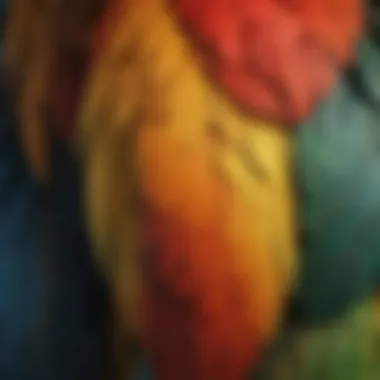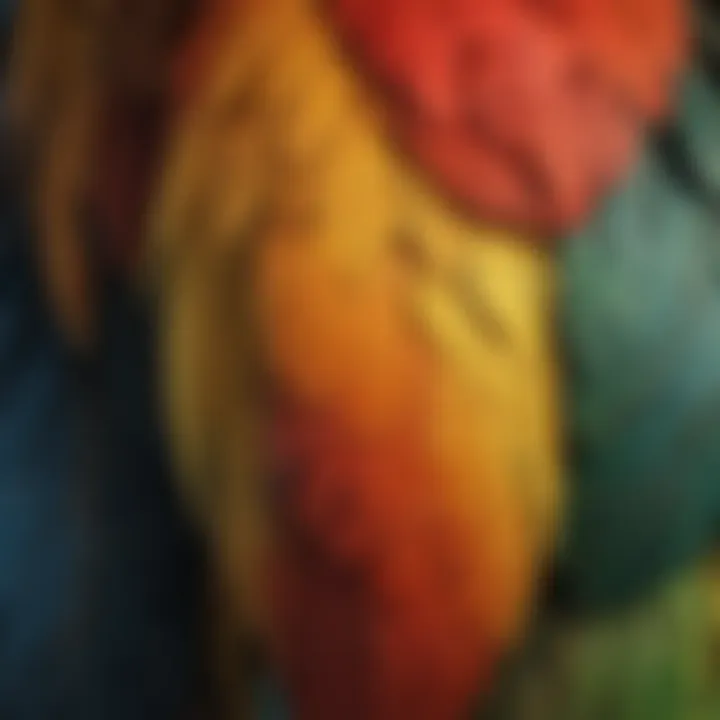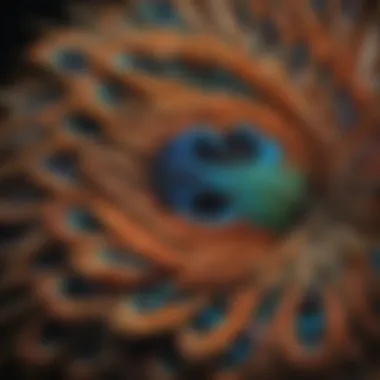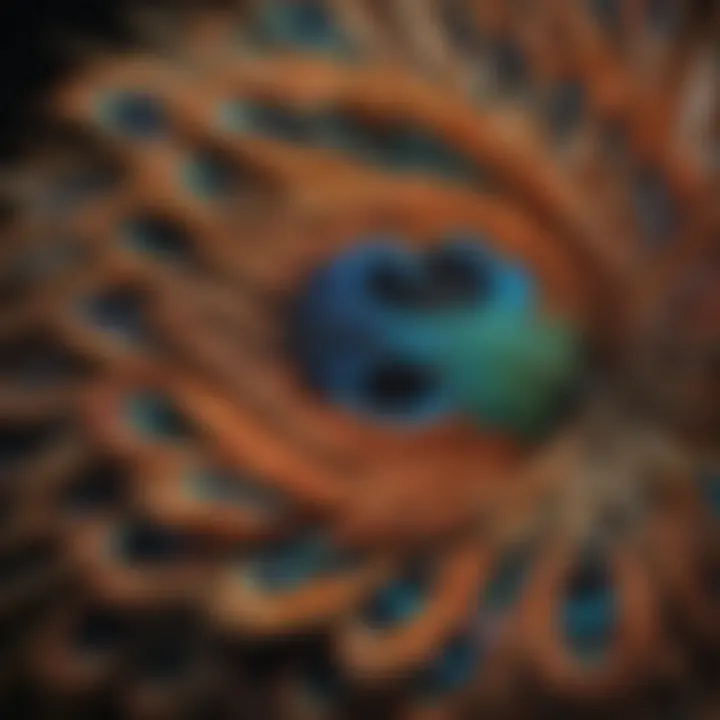Bird Identification by Color: A Complete Guide


Intro
Birdwatching can often feel like a treasure hunt. You have to piece together clues while out in the field, where the vibrant colors of our feathered friends jump out against the backdrop of nature. Understanding how to identify birds by color is both an art and a science. It’s not just about the flashy hues but also about the subtleties that differentiate one species from another.
This guide dives into the world of bird identification, focusing specifically on how color plays a pivotal role in recognizing various avian species. Whether you're peering through binoculars for the first time or you're a seasoned ornithologist, the significance of color makes the task of birdwatching much more engaging.
Coloration in birds can be influenced by a host of factors ranging from genetics to environmental conditions and even the season. Moreover, understanding how different cultures perceive these colors can add another layer of depth to your knowledge. As we weave through this narrative, you'll pick up practical insights and tips to enhance your birdwatching experience, making each outing more rewarding.
"Birds show us nature's palette; wisely interpreting it makes all the difference."
Let’s begin by exploring some care tips that can enhance your observatory experience.
Understanding Color in Birds
Birds are not only remarkable for their diverse behaviors and habitats, but color also plays a critical role in their identification. Understanding how color functions in birds can transform the way bird enthusiasts approach their observations. When you step outside and see a flash of red, green, or blue, that hue doesn’t just give the bird its beauty—it carries significant meaning that can help in identifying a species.
Bird watchers often rely on color as one of the first features they notice when trying to pinpoint a specific bird. However, you shouldn’t just stop at recognizing a color. The nuances of shade and brightness can greatly aid in distinguishing between similar species that might appear confusing at first glance.
The Role of Color in Bird Identification
It’s no secret that different species come in various colors, but these colors can serve more than just aesthetic purposes. Colors may signal maturity, location, or even health, all of which can be crucial for identification. For example, many male birds flaunt vivid plumage during the breeding season as a signal to attract mates.
Identifying birds by color can be an adrenaline-pumping challenge. This method encourages people to pay close attention to not just the color, but to the patterns and shapes that accompany them. It's almost a puzzle where every piece matters! Understanding the role of color also aids conservation. Knowing which birds are widespread or endangered can inform preservation efforts.
Color Perception in Different Species
Birds have an advanced visual system that is flexible compared to our own. While humans generally see three primary color wavelengths, many birds can detect ultraviolet light, which enhances their perception of color and patterns. This capability influences not only how birds identify one another but also how they interact with their environment.
Similar to how some people might look at a sunset and see an array of colors that others might miss, different species interact with color in unique ways. For example, a sparrow may respond to subtle variations in color that are imperceptible to the human eye, allowing it to choose mates or locate food more efficiently. It's a vivid reminder that the avian world has complexities that are just waiting to be discovered.
Physical Mechanisms of Coloration
Coloration in birds is a fascinating interplay of biology and environment. At the core of this dynamic are three main mechanisms: structural coloration, pigmentation, and environmental effects.
Structural Coloration
Structural coloration is a phenomenon where color arises from the microscopic structure of feathers rather than pigments. Essentially, the arrangement of microscopic layers reflects particular wavelengths of light. A prime example is the iridescence seen in birds like the Blue Jay or the Morpho butterfly. This ability to reflect light can create brilliant hues that shift depending on the angle from which they are viewed.
The key characteristic of structural coloration is its vibrancy and variability, which can make these colors incredibly striking. Using structural coloration as a basis for identification is a beneficial choice, as many birds rely heavily on these features for social signaling. However, it can also present challenges, as the brilliance may not always be consistent in varying lighting conditions, necessitating careful observation in different environments.
Pigmentation
Pigmentation arises from chemicals in a bird's feathers, which absorb certain wavelengths and reflects others. For example, the bright yellow of a Goldfinch comes from carotenoids, which not only provide color but are also tied to the bird's diet. When you witness a yellow finch flitting by, it might pique your interest because of its lively color, but what's more fascinating is the story behind that hue.
The key characteristic of pigmentation is its ability to encode nutritional health. Birds that have vibrant colors often have diets rich in the required pigments, signaling their vitality. However, reliance on pigments creates limitations; certain environmental factors can diminish these colors over time, which presents both challenges and opportunities for identification.
Environmental Effects
Environmental effects also contribute significantly to how color is perceived. Factors like seasonal changes, habitat types, and even the time of day can alter how colors appear to both birds and observers. The colors of feathers might appear duller during the rainy season or more brilliant against a clear blue sky.
Understanding the environmental influence allows bird watchers to adapt their patterns of observation. For instance, during dawn, different shades may be visible as the sun rises, creating a distinctive atmosphere that imparts various hues to birds. This is a compelling notion that adds a layer of depth to bird watching; it invites individuals to not only observe but to think critically about their environment as they identify species.
In summary, examining color in birds involves delving into a rich tapestry of biology, perception, and environment. This intricate web can be both rewarding and complex, and understanding it can enhance the experience of spotting and identifying birds in the wild.
The Spectrum of Bird Colors
Understanding the spectrum of bird colors is crucial in the realm of birdwatching and identification. Color plays a significant role in distinguishing species, attracting mates, and even avoiding predators. By familiarizing ourselves with the different shades and palettes, we enhance our ability to spot and identify various birds in their natural habitats. This section provides a roadmap for navigating the vibrant world of avian colors, allowing both novice and seasoned bird watchers to deepen their observation skills.
Common Color Categories


Birds can be classified into several common color categories. Each category not only adds to the aesthetic component of birdwatching but also serves as a practical tool for identification. Here, we’ll look closer at the primary shades: blues and greens, reds and oranges, yellows and creams, as well as browns and grays. Each of these categories features distinctive elements that not only grace the feathers of our feathered friends but also assist in recognizing them in the wild.
Blues and Greens
The domain of blues and greens paints a picture of nature that is often associated with tranquility and freshness. These colors can be especially prominent in species like the Blue Jay or the Green McCaw. A defining characteristic of this category is its ability to reflect light in a way that creates vibrancy. Blues and greens are prevalent in many bird species, making them an advantageous choice for identification.
The most striking feature of these hues is their adaptability to varying environments. For instance, deep blue can help a bird camouflage within a lush backdrop while standing out remarkably in other settings. However, one downside is how sometimes these shades can appear muted under certain lighting, especially in heavily wooded areas, which can pose a challenge when attempting to identify a bird at a distance.
Reds and Oranges
Reds and oranges bring a burst of energy and are often linked to caution or attraction. Birds like the Scarlet Tanager exemplify these vibrant shades. A standout aspect of this color palette is its effectiveness in mating displays; bright colors often signal health and vitality to potential mates, making them an essential element in breeding practices.
However, it’s not all sunshine and roses. While these colors can make some species easy to spot, they also increase visibility to predators. A vivid orange or red hue can catch the eye of a lurking hawk or snake. Therefore, these colors play a dual role in both attracting mates and ensuring survival.
Yellows and Creams
Yellows and creams create an aura of warmth and friendliness. Birds like the American Goldfinch showcase these bright shades prominently. The key characteristic of this category is its visibility. Bright yellow stands out against various backgrounds, making it a common choice for identification. In a sea of green leaves or earthy tones, a flash of yellow can be a beacon.
Moreover, these shades can signal different behaviors. For instance, certain species may utilize yellow in their plumage to communicate with others, indicating readiness for breeding or possession of other resources. Nevertheless, it’s important to note that cream colors can sometimes blend with sandy environments, possibly complicating identification in certain habitats.
Browns and Grays
Often understated, browns and grays contribute to the more subtle aspects of bird identification. Birds like the Eastern Towhee display these muted tones which allow them to blend seamlessly with their surroundings. This color category is significant for its camouflage abilities.
The primary characteristic of browns and grays is their versatility, integrating smoothly into a variety of environments—from the forest floor littered with leaves to the rocky terrains of mountains. On the downside, birds with these colors can be difficult to distinguish, especially from a distance or in dim light. The commonality of these shades among various species can lead to confusion, complicating efforts to identify them accurately.
Mimicry and Coloration
Mimicry in birds fluctuates between fascinating and bewildering. It involves species adopting coloration that resembles other birds or aspects of their environment. This adaptation can serve multiple purposes, from attracting mates to evading predators. Mimicry can also play a significant role in the subtleties of hunting or foraging strategies. Here, we dig deeper into the mechanics behind mimicry and its profound influence on bird coloration, also considering how this phenomenon impacts bird identification.
Practical Identification Techniques
Identifying birds by their color isn’t just about spotting a vibrant feather; it’s a detailed process that requires specific techniques and tools. This section emphasizes the importance of employing practical identification techniques that can enhance the birdwatching experience. Accurate identification merges observation and understanding, allowing enthusiasts to appreciate the diversity of avian life. The use of color as a guide can be quite helpful, but it must be paired with techniques designed for thoroughness.
Field Guides: Utilizing Color for Identification
Field guides are indispensable tools for bird enthusiasts. They provide a treasure trove of information, combining detailed illustrations and descriptions to help in distinguishing species. These books often categorize birds using color, making it easier to identify them in the wild. For instance, a guide focused on the eastern United States might arrange birds by their shiny blues or rusty reds. This structured approach is crucial during those fleeting moments when a bird flits by — having a guide that points out specific colors can lead to quicker identification.
"An excellent field guide is like having a knowledgeable friend accompanying you on your birdwatching trips."
When selecting a field guide, pay attention to the color quality of the images. Some guides feature more true-to-life illustrations, which can affect recognition during observation. It's wise to carry along a guide that includes various regional birds, as local species can differ significantly.
Photography as a Tool for Identification
Using photography in bird identification offers a unique advantage. It allows a birdwatcher to capture moments that may last only seconds. A photograph can become a lasting reference for identifying species, which may be missed during the initial sighting.
Capturing Accurate Colors
Capturing accurate colors is vital in bird photography. The lighting conditions can drastically alter how colors appear, meaning that what one sees in the field might not match the image taken later. For instance, a bird that appears bright yellow under the midday sun can transform into a muted tone during twilight.
To ensure a photograph reflects the bird's original colors, shooting in natural light is typically the best approach. One key characteristic of capturing accurate colors is utilizing the correct white balance settings on your camera, so hues remain true. While taking that shot, consider the background as well; bright contrasting backgrounds can distort color perception.
However, a potential downside is the dependency on equipment quality. More expensive cameras with better lenses often yield superior results. The amateur photographer might find it tricky to capture those vibrant details without investing in gear.
Post-Processing Techniques
Once photographs are captured, post-processing can enhance them. This technique involves editing images to improve lighting and color balance, which can compensate for issues faced during the shooting phase. One distinctive aspect of post-processing is adjusting the saturation and contrast to more accurately reflect a bird’s color.
A critical advantage of effective post-processing is the ability to highlight specific features, such as feather texture and subtle gradients that may not have been visible initially. However, bear in mind the fine line between enhancement and over-editing; maintaining a natural look is paramount. If done excessively, a photograph might end up showing colors that misrepresent the actual bird, leading to confusion.
Behavioral Observation


Not all bird identification hinges on color alone. Observing behavioral traits can provide essential clues. For instance, a bird’s foraging habits and flight patterns often coincide with their physical attributes.
Sighting a bird and noting how it interacts with its habitat can create a more comprehensive picture. A bird with vibrant colors might showcase specific behaviors during courtship, like soaring high and performing acrobatic flips, which can further aid identification beyond just color.
In summary, practical identification techniques leverage field guides, photography, and behavior observation to enrich one’s understanding of birds. Mastering these can lead to a more profound appreciation of England's avian world.
Color and Bird Behavior
Understanding the interplay between color and bird behavior is crucial for both bird watchers and enthusiasts. Color not only aids in identification but also signifies various behavioral traits that are intrinsic to different species. This exploration emphasizes that the vibrant hues we see are often manifestations of deeper ecological strategies, serving as tools in survival, mating, and social interactions. By examining these traits, one gains a comprehensive insight into how birds adapt to their environments and utilize their colors for various purposes.
Foraging and Feeding Habits
Birds exhibit a fascinating range of foraging techniques that often correlate with their coloration. Bright colors can signal to predators that a bird is poisonous or unpalatable, a warning dressed in nature's palette. For example, the brightly colored American Robin uses its red-orange breast not just for mating display but also as a way to communicate its presence in specific feeding territories. The audacity of color can help birds establish dominance over feeding grounds.
In contrast, more muted colors often belong to birds that employ stealth and camouflage during foraging. The Northern Flicker, which features a subdued brown plumage, relies on its color to blend into the environment, allowing it to forage effectively on the ground without drawing attention.
- Key Points:
- Bright colors signal potential toxicity.
- Subdued colors aid in camouflage during foraging.
- Foraging behaviors can vary widely, influenced by color perception.
Mating Displays
Color plays an often dramatic role when it comes to mating displays. The hues displayed during courtship can be essential in attracting a mate and ensuring species propagation. For instance, the male Peacock, with its spectacular display of iridescent feathers, uses vibrant colors to catch the eye of potential mates. These colors reflect genetic health and vitality, compelling mates to choose visually appealing partners, often leading to breeding success.
Moreover, color variations can convey information about an individual's fitness. A brighter male may signal superior health, while a dull-colored male could indicate susceptibility to diseases or lack of access to resources. Consequently, it can lead to a mating preference that heavily favors colorful males, impacting the gene pool.
"In bird courtship, color acts as a signal of health, vigor, and suitability as a partner."
- Key Points:
- Colorful displays attract prospective mates.
- Brightness can indicate overall health and genetic quality.
- Preferences for color can shape future generations.
Territorial Markings
Birds use coloration as a critical element in marking their territory. The combination of color patterns can convey messages to rivals about boundaries. For example, the Scarlet Tanager uses its striking red and black plumage to assert dominance and deter intruders. The conspicuous coloration not only highlights the bird's presence but also discourages rival males from encroaching on established areas.
In many species, females also exhibit a muted coloration that aids in nesting and rearing young, contrasting with the vivid plumage of males. This differentiation highlights the importance of color in groups where territorial disputes might arise. Thus, understanding the significance behind these territorial displays provides insight into social behaviors and bird dynamics in varied ecosystems.
- Key Points:
- Color serves as a deterrent to rivals.
- Territorial behaviors are often pronounced in brightly colored species.
- Female coloration often supports reproductive strategies through camouflage.
Engaging with the nuances of bird behavior tied to color enhances our understanding of these avian creatures. By recognizing the strategic use of colors in foraging, mating, and territorial claims, aspiring bird enthusiasts can deepen their appreciation for the complexity of their world.
Challenges in Bird Identification
Bird identification is a nuanced endeavor, and the element of color adds both depth and complexity to the task. Understanding the challenges that arise in this process is crucial for enthusiasts at all levels. The variability in color can stem from many factors including genetics, environmental conditions, and behavior. Even seasoned birders can find themselves stumped by a seemingly simple identification question, as a fleeting glimpse of color often does not provide the entire picture.
A well-rounded birdwatcher must appreciate these hurdles in their observation. First, recognizing that color can be a fluid concept rather than a static one is vital. It can fluctuate drastically depending on various external factors. Learning to navigate these challenges equips enthusiasts to better enjoy their hobby and to understand the vibrant lives of the avian species.
Color Variability Within Species
Color variability within a species can be a double-edged sword. Take the American robin for instance; while many identify it with a bright orange breast, the shades can differ significantly among individuals due to age, sex, and even local environment factors. Younger robins, for instance, may sport a pale or speckled breast, misleading those trying to use color as a primary identifying feature.
Further, seasonal changes can play a role. Many birds undergo molt, changing feathers and coloration with the seasons. Winter plumage versus summer plumage often leads to confusion. For example, male ducks such as the mallard showcase vibrant colors in the breeding season, but revert to more muted tones when preparing for colder months, camouflaging themselves against predators.
"Color is not just a shade; it's a story that tells of survival, adaptation and sometimes, a journey of transformation."
Hybridization and Its Effects
Hybridization presents another layer of complexity in identifying birds by color. As populations intermingle, characteristics of different species can blur, resulting in individuals with mixed traits. A classic scenario is the pairing of the blue jay and the Steller's jay. Both share a general blue hue, yet specific patterns vary. Analyzing such hybrids can mislead an identifications, since the colors and patterns may not be typical of either parent species.


Birds that hybridize often carry traits that are very different from their pure-bred family, adding confusion for anyone reliant on color. Moreover, in certain areas, hybridization can amplify the challenges, as regional variations in color might emerge, further complicating identification processes.
Impact of Lighting and Environment
Lighting conditions can significantly affect how colors appear. A bird that looks one way under the early morning sun might look entirely different as the day goes on. Subtle hues can become pronounced or washed out based on shadows, reflections, or direct sunlight. This fluctuation demands that bird watchers pay close attention to the surrounding light conditions.
The habitat itself also contributes to color perception. Birds that dwell in dense foliage, for instance, might appear darker due to limited light exposure, whereas those in open fields could showcase brighter, more vibrant colors. Being aware of these effects can aid in making more accurate identifications and enrich the overall bird-watching experience.
Overall, these challenges emphasize the importance of an observant and flexible mindset among bird enthusiasts. By understanding the complexities surrounding color variability, hybridization, and the impact of environmental factors, birdwatchers are better equipped to appreciate the rich tapestry of avian life.
Cultural Significance of Bird Coloration
The colors displayed by birds transcends mere aesthetics; they penetrate deep into the fabric of various cultures, revealing insights about symbolism, beliefs, and even social practices. Understanding the cultural significance of bird coloration enriches our appreciation of these creatures, as it embodies not just the biological aspects of bird life but also the human experiences intertwined with them. The vibrant hues that characterize bird species often serve as a canvas for cultural expression, ranging from traditional folk beliefs to contemporary art forms. This section delves into how color influences perception and symbolism in different cultures and its reflection in artistic tradition.
Symbolism in Various Cultures
Bird coloration is not just a feast for the eyes; it also carries deep-rooted meanings in many cultures around the world. For instance, the vivid red of the Scarlet Macaw is often linked to passion or the spirit in indigenous South American cultures. Similarly, in various Asian traditions, the color white often symbolizes peace and purity, making the White-throated Sparrow a sign of good fortune.
- India: In Indian culture, the peacock, with its iridescent feathers, is not just a bird but a symbol of grace and beauty. It represents love and is often depicted in ceremonies and festivities.
- Native American Traditions: In many Native American cultures, specific colors of birds connote different traits. The black of the raven, often associated with mystery and intelligence, is a common motif in storytelling.
- Chinese Culture: In Chinese tradition, the Crane is revered as a symbol of longevity and wisdom. Its stark white feathers are said to connect the heavens and the earth, embodying spiritual journey.
These examples reflect just a fragment of how bird colors are woven into the cultural narrative, often used to convey emotions, beliefs, and aspirations.
Birds in Art and Literature
Birds, with their captivating colors, have been the muse for artists and writers alike, prompting the portrayal of their vibrant hues in a multitude of expressions. The symbolism packed into the colors of these creatures extends far beyond what one might notice at first glance.
- Art: Artists have long drawn inspiration from birds’ colors. Vincent van Gogh’s "The Harvest" displays a nuanced palette, depicting colorful birds fluttering amidst fields. His use of colors evokes feelings of vitality and energy in nature. Similarly, contemporary artists employ avian imagery to explore themes of freedom and change.
- Literature: In literature, authors frequently use bird symbolism to reflect deeper themes. The colorful plumage of exotic birds often represents forbidden desire or unattainable goals. For instance, in the poem "The Fish" by Elizabeth Bishop, the speaker's reflections on vibrant birds symbolize the complexity of life and human experience.
Art and literature not only celebrate the aesthetic allure of birds but also unearth intricate layers of meaning that resonate with readers and viewers, enriching cultural discourse on identity, nature, and existence.
"Birds act as a bridge connecting the natural world with human imagination."
In sum, the cultural significance of bird coloration reveals a fascinating interplay between nature and human societal values. The interplay of color and symbolism leads to a greater appreciation for avian life, making it not just about identification, but also about understanding our relationship with the natural world. Knowing these cultural nuances can deeply enhance the experience of watching birds in their natural habitats.
Conservation and Bird Color
The interplay between bird coloration and conservation has become a pressing issue in the face of environmental changes. Color is not just a captivating aspect of avian species; it also serves critical functions in their survival and reproduction. Understanding this relationship helps us appreciate the urgent need to protect habitats and, by extension, the colorful lives within them.
Birds’ colors can signal health, breed status, and their ability to thrive in a shifting ecosystem. Not so long ago, the brilliant plumage of a Blue Jay might have been taken for granted, yet this bold hue often signifies a bird's access to adequate resources. With habitat destruction and climate change affecting the availability of food and nesting sites, these colors can reflect whether a species will endure or face decline.
To put it plainly, losing a bird's striking colors may mean losing that bird altogether. Protecting the environment not only allows these colors to flourish but also maintains the balance of the ecosystem itself. Their colors attract mates, ward off predators, and even help with foraging—each a piece of the delicate puzzle that keeps bird populations sustainable.
"A vibrant bird can brighten your day, but its decline signals a much graver issue at hand."
Impact of Habitat Loss on Color Variation
Habitat loss is a villain in the tale of conservation, affecting not just bird numbers but also their vibrant colors. When environments are altered or destroyed, the intricate relationships between color, habitat, and survival come undone. For instance, some species adapt their colors to blend in with their surroundings, a trait crucial for avoiding predation. If those habitats shrink or disappear entirely, the associated adaptation can become less viable.
Moreover, habitat destruction often leads to reduced resources. Less availability of food results in poor health during feathers' growth phases. The stress from lack of resources may dull colors that are pivotal for attracting mates.
Key points to consider:
- Fragmented Habitats: Divide populations, leading to isolated gene pools and odd color variations.
- Loss of Food Sources: Affects health, leading to pallor in once-vibrant feathers.
- Altered Breeding Success: Duller birds may struggle to attract mates, leading to reduced reproduction rates.
As habitats suffer, so does the spectrum of colors that once painted our natural world.
Role of Color in Species Conservation
Color isn't just a visual treat; it's a tool that plays a significant role in the conservation of species. Bright colors often indicate health and vitality, both crucial for successful mating strategies. Species that exhibit dazzling plumage are often the targets of conservation efforts, as their visibility can bring attention to the broader issues affecting their habitats.
Conservationists utilize the allure of bird colors in outreach and education efforts. Public interest is often piqued by the eye-catching aspects of birds, leading to greater engagement in conservation activities. People are drawn to vibrant species like the Scarlet Tanager or the Goldfinch, making them ambassadors for their habitats.
Consider the impact of well-known bird species:
- Scarlet Tanager: Its bright red plumage captivates bird watchers, creating awareness about forest conservation.
- Goldfinch: Popular among bird feeders; its colorful presence encourages planting native plants that support diverse bird life.
By understanding and promoting the role that color plays in these species, we not only enhance conservation efforts but also instill a deeper connection within communities. Every vibrant feather leads to a broader conversation about maintaining the natural beauty around us. These colorful creatures serve as a reminder—protecting their habitats is vital for their survival and, ultimately, ours.















